
HMMMM...so that's how it's done. Stan Kowalski ponders his next move in AF4b building. (Note mandatory moaning chair.)
Contents:
Contact info:
Jim Michalak
118 E Randall,
Lebanon, IL 62254Send $1 for info on 20 boats.
Jim Michalak's Boat Designs
118 E Randall, Lebanon, IL 62254
A page of boat designs and essays.
(15August2011)This issue will talk joining sheets of plywood. The 15 August issue will be about scarfing solid lumber.
THE BOOK IS OUT!
BOATBUILDING FOR BEGINNERS (AND BEYOND)
is out now, written by me and edited by Garth Battista of Breakaway Books. You might find it at your bookstore. If not check it out at the....ON LINE CATALOG OF MY PLANS...
...which can now be found at Duckworks Magazine. You order with a shopping cart set up and pay with credit cards or by Paypal. Then Duckworks sends me an email about the order and then I send the plans right from me to you.
Butt Joints In Plywood
BACKGROUND...
Almost any boat you build from plywood will require panels longer than the 8' lengths you will find at the lumberyard. For an "instant boat" the usual manner of joining the panels together to get one long panel is with a butt strap or butt plate. I've tried lots of different ways to make the joint in the 15 or so boats I've built over the years. All the methods worked. I have a feeling that the butt joints on the usual instant boat hull are not highly loaded and not too critical to overall boat strength. Since I've tried several ways and they all worked I've gotten to be pretty nebulous about the subject on my drawings. Lately I've been specifiying a butt plate as something like "Butt plate from 3/4" x 3-1/2" lumber, or equal" which doesn't tell you much. Most builders get by pretty well with just that but recently one builder asked what in the world I meant, and rightly so. So let's start the discussion with one joint I've never tried in plywood.
TRADITIONAL PLYWOOD SCARF JOINT...

Figure 1 shows the traditional plywood scarf joint. I''ve never done this in plywood although I've made a lot of scarf joints in plain lumber. The two overlapping faces are tapered and glued together such that both joined faces remain smooth. If you are building a traditional lapstrake boat from plywood you have to make the joints this way.
What's good about it? The faces are smooth both sides. Essentially you have a single piece of wood to work with after making the joint. It's quite strong, as strong as the base wood provided the taper is long enough. I've seen the taper range from 6:1 to 12:1. The shorter tapers are easier to make and probably just as good given modern glues.
What's bad about it? The tapers can be hard to make properly although thickened epoxy has made experts of most of us. Some experts have special saw rigs to cut the taper. Most use power hand planes or belt sanders, I think. When gluing the joint you must press it up against a firm surface while the glue cures, making sure nothing glues to that surface, and making sure the two pieces are secured lengthwise so the tapers don't push them apart as you apply clamping pressure.
There is one more warning for instant boat builders. Almost all instant boat designs have panels layouts which assume you will not be using a scarf joint. If you join two 8' panels with a scarf joint you will NOT end up with a 16' panel. It will be shorter by the overlap amount. That might be just enought to negate the ply panel layout.
THE PAYSON TEAL BUTT STRAP...
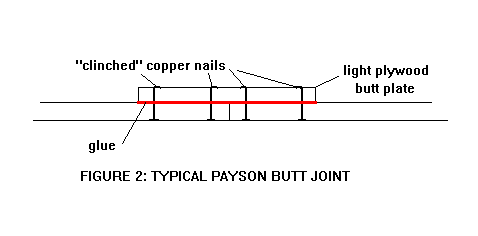
I think this type of joint was described in Payson's great book INSTANT BOATS. I used it on my Teal which was my first homemade boat. The side panels were 1/4" thick on my boat, the bottom 3/8". The butt straps were 3/8" plywood, 6" wide. So the effect of the joint was similar to a 12;1 scarf on the 1/4" ply sides and about 8:1 scarf on the bottom. The nails were supposed to be copper, but I think Harold might have also suggested copper rivets or short bolts for fasteners.
What's good about it? It's pretty simple to visualize and make. If the fastening is good you can make the joint and go right on building without waiting for the glue to set. You might do that with the sides, for example. Another neat thing about this plain butt strap joint is that, with a typical flat iron skiff type of assembly, the bottom panels need not be joined before assembly onto the hull. In that case you will have the hull inverted on sawhorses ready for the bottom. Then you put the first bottom piece on attaching it to the sides. Then you install the first butt strap at the end of that piece. Then you install the next bottom panel to that butt strap and the sides. And so forth until the entire bottom is planked, like laying bricks.
I might mention now that I think butt straps and plates should be well rounded at the ends to avoid trapping dirt and moisture. In boats that have taped seams I advise stopping the butt strap short of the edge of the panel so you will have room to run the tapes undisturbed. This is especially true of butt straps on the bottom. You must have a clear limber channel around the perimenter of the bottom. In that case I stop the strap about 1/2" short of the side, fill the little gap with epoxy to keep the water out, and tape over the bottom of the joint with glass tape and epoxy. Usually I don't put glass tape over the outside of the side panel joints. But butt joints in any deck should be well sealed with glass and epoxy. Here is an end view of the treatment:

What's bad about the plywood strap? I think in Maine you aren't a man until you've made a boat with clenched copper nails or rivets. Not so where I live, can't buy them any place I know of. I got by with bronze boat nails but they really aren't flexible enough for the job. They didn't look too cool. And the edges of the plywood butt straps don't look too cool either, wanting to have gaps and splinters showing. It takes a while to finish them. And, of course, you have a lump at each joint and folks will ask, "What's that?"
By the way, when I built my Toto I used the simple plywood strap method with no fasteners. Just carefully lay the ply panels over the straps which were well buttered with glue, weighed it all down with concrete blocks to provide pressure, and stayed away for a few days until I was sure the glue was totally set.
THE BIRDWATCHER BUTT STRAP...

When I built my Birdwatcer in 1988 I think I piled on more layers of plywood straps such that I wouldn't have to bend over the nails. And by that time I was more expert at finishing the edges of plywood. It worked but it was very obvious that I could have done the same thing with regular lumber and saved a bit of work.
THE LUMBER BUTT PLATE...
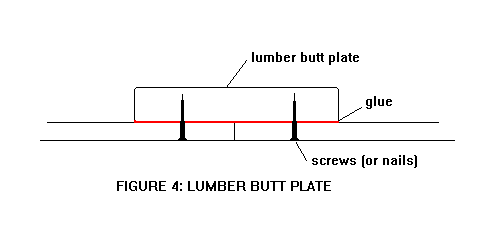
This is what I like to advise now. Not much to it. Very quick and easy to make. Some say it looks too clunky for their tastes.
If there has been any structural problem with the above butt plate it is at the ends of a plate that joins bottom panels, ending short of the sides to allow a limber path. If the ends of the plate are not solidly glued and fastened to the bottom panels the butt plate will eventually loosen at the ends. I think that is due to the rapid change in flexibility in the system where the plate suddenly ends. A better solution might be to taper the end of the bottom butt plates starting maybe 3" in from the end of the plate and tapering down to maybe 3/8" thick at the ends. That will allow a gradual change in the flexibility and prevent a stress riser at the end of the butt plate. By the way, for any bulky butt joint care must be taken in design to see that the joints don't fail in places where the butt plate will be in the way.
LIGHT FIBERGLASS BUTT JOINTS..

Both Harold Payson and Dave Carnell presented this one to U.S. readers in the '80's but I'll bet the English inventors of taped seam boats did it earlier. Simple as can be in theory. Just a layer of fiberglass on each side of the plywood.
Dave Carnell presents lots of details at his web site. He has done scientific load tests of these joints and says the joint will be as strong as the base wood if you use one layer of fiberglass cloth in epoxy on each side of 1/4" plywood, two layers on 3/8" plywood, three layers on 1/2" plywood, and four layers on 3/4" plywood.
I used the glass butt joint on my Roar rowboat but went back to wooden butt joints later. At first it would appear that the joint is easily made by laying the ply pieces on the floor, taping one side with fiberglass, waiting to cure, flipping the panel and repeating on the other side. But I found that plywood on its own often does not want to lay flat enough to get a smooth fit, so I had to place the joint over a board and screw the pieces down flat. Next the idea of flipping the panel with only one side taped doesn't work well because that one layer of glass has little strength by itself. But it can be done carefully. Better yet is what both Payson and Carnell advise: glass both sides at once. Lay the first side of fiberglass layers wet with epoxy on a protected flat surface, lay the plywood to be joined upon it, lay the second side of fiberglass over the top of the joint, cover with plastic sheet and weigh down with concrete blocks. The plastic sheeting not only protects everything from gooey epoxy, but it should provide a smooth final finish and if you are lucky no filling or sanding required afterward.
THE PAYSON HEAVY GLASS JOINT...
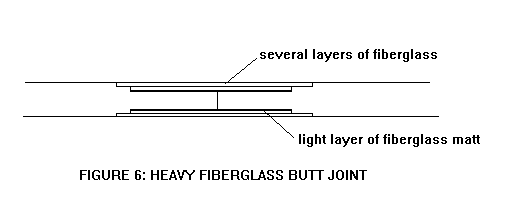
Harold Payson did a little more work on the glass butt joint. I'm doing this from memory and hope I'm getting it right. To hide the build up of glass on a thicker sheet of plywood he recessed the surfaces roughly with a sanding disk in a drill. Then he added a layer of light fiberglass matt to the wood before pasting in the glass. Fiberglass matt is generally thought to provide better adhesion to wood than glass cloth although by itself it has little strength. Harold is big on using polyester resin on his boats instead of epoxy so perhaps the matt is more important for the polyester users. But you can see the advantage of the system: the final joint can be more or less invisible as the multiple layers of glass are recessed.
Cormorant
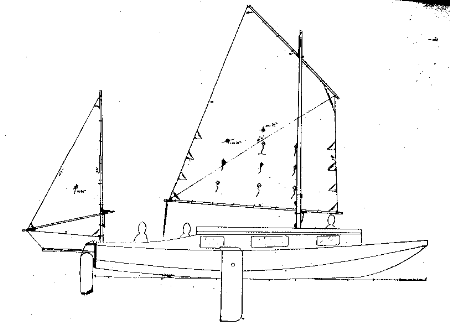
CORMORANT, CABIN SAILBOAT, 32' X 8', 2500 POUNDS EMPTY
Cormorant is the largest boat I've ever designed. I always warn folks to think twice and three times before building a big boat because you can buy a good used glass boat for less, maybe a lot less. But a homebuilt boat can have features that aren't available in a production boat and so it is with Cormorant. This one is really a 20% enlargement of Caprice.
Straight enlargements rarely work perfectly and so it was with Cormarant from Caprice. (Don't forget that Caprice was an enlargement of Frolic2, etc., etc., right on down to my Toto canoe.) In this case I narrowed it from a straight enlargement to keep the width within simple towing limits since this large boat is supposed to live on its trailer most of the time. The layout is quite similar. The idea is that the adults sleep in the center cabin and the kids sleep in the forward room.
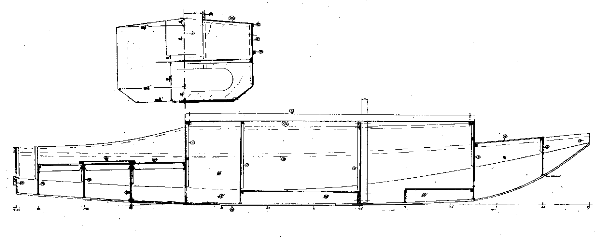
Like Caprice, Cormorant has water ballast, over 1000 pounds of it. Total floating weight with family is going to be up to 4500 pounds. You don't tow a boat this large behind a compact car but I think towing this sort of weight is common today, all done with expensive large trucks I'm afraid.
The sail rig looks pretty modest with a 207 sq foot main. I'll bet it is enought since this shape is easily driven. I don't think you can go any larger and still hope to handle it without extra crew and gear.Tthe lug sail shown is similar in size to Bolger sharpies and they seem to get by OK. Experience will show if it is too big/too little.
Constuction is taped seam, with no jigs or lofting. Unlike smaller designs this one does not come with a plywood panel layout drawing. Over the years I've learned two things about the ply layout page. First is that almost no one uses it. Second is that with a larger boat the work of finding and drawing and fitting all the pieces to the boat on scale plywood sheets overwhelms all the other work. So part of the deal with doing the design was that there would be no plywood layout drawing. However this is still a true "instant boat" in that all of the parts that define the boat are drawn in detail and you can scale them up on plywood, cut it out and fasten together with no need for lofting or a building form.
Garth Battista, who is a book publisher at Breakaway Books where he publishes sporting books including my Boatbuilding For Beginners (And Beyond), is a true boat nut and has worked himself up from dinghies and canoes to the big Cormorant. He took it initially on a quick shakedown run on a lake near his home and shortly later to Long Island Sound for a week with his family. Here are his comments:

"We had an amazing time living aboard Cormorant (christened "Sea Fever") in Provincetown harbor for 5 days. The tide there was rising and falling about 12 feet a day with the full moon. We'd be high and dry up on the beach for breakfast, swimming off the boat at lunchtime, walking the flats again by dinner. It was a blissful time for me and my wife and two girls. We moved around, took little sails here and there across the harbor (West End to Long Point, then to the lighthouse, then to the East End, etc.) anchoring here and there, usually just running it aground as the tide allowed and staying for a while. Many shells were collected, and tidal pools investigated. Of all the harbors I've ever seen, it is the most alive. It's a couple of miles across and fresh sea water flushes the whole place twice a day. The number of snails, clams, crabs, fish of all sizes, mussels, eelgrass, etc. was just mind-boggling. On high tides I'd go spearfishing (many attempts, no luck) where at low tide I'd been walking around.

We rigged a 8' x 15' white tarp with tent poles running crosswise as a canopy over our cockpit and hatch, supported along the mast folded down in the tabernacle, so we could escape the mid-day sun. Most days were hot and humid and mild, with only gentle winds. We rode out a nighttime thunderstorm with no trouble, just stayed up and watched the lightning. We attended a few wedding-related events, just walking ashore for one party, and for the wedding itself we returned late at night and rowed our dinghy out to the boat, our sleepy children just awake enough to get themselves aboard.

For our last two days we gave up the shallow-water life and sailed from P-town down to Wellfleet, about 7 miles, surfing along on gentle 3-foot waves with a following wind. We beached the boat at Great Island, walked the beach, had a picnic dinner, swam and played, spent the night, and left the next morning at 6 a.m. to beat the falling tide. Our weather radio mysteriously quit working that morning, so all we had was the prior day's forecast of 10-15 knot winds from the SW.

The wind had shifted into the west during the night, so we had to beat out of the harbor, and once we turned north to return to Provincetown, huge rollers were coming in off the bay, more or less directly into our port side, lifting us, rolling us, occasionally breaking and spraying water into the boat. We stayed well offshore to avoid the breakers in by the beach -- but with the falling tide it seemed that we needed to be nearly a mile out. It went from exhilarating to worrisome to mildly terrifying as we neared P-town and the wind kept picking up, past 20 knots to 25 and higher in gusts, and the waves just kept growing. The swells were in the 8-10 foot range, with a high percentage of them breaking at their tops, whitecaps everywhere.

But bless this boat! With its 1000 lbs. of water ballast, and the leeboard mostly up, we were able to bob and roll and slide over nearly all the swells. The worst of them were very steep and threw us sideways, maybe tilting us to 40 or 45 degrees briefly. We had two reefs in the main and the mizzen rolled down to about half-size, and still we blasted along on this nasty rollercoaster of a beam reach. It was the sort of trip that would be scary fun if it was just you and a buddy, but it's awful when you have your loved ones aboard, and you wonder who might get thrown overboard, and how you'd managed a rescue in the rough conditions.

Anyway -- the white knuckles got to relax as we finally made it past the P-town breakwater, and with great relief ran her aground out on the flats. The gale (or near-gale) continued to blow all day, kicking up 3 and 4-foot waves even in the protected areas of the harbor. The only boats we saw going out were an 80-foot schooner and a big whale-watch boat. A lobsterman we talked to later said he'd stayed in as it was too rough to check his traps.
We had a hell of a time taking the boat out and getting her on her trailer for the trip home -- but all worked out in the end, with the assistance of some very kind strangers; and I'm left with the memories of incredibly happy days. -- And an incredible boat.

All best, Garth
P.S. Jim -- I should also mention that on Sunday afternoon as we turned the corner from our run down to Wellfleet to the close reach upwind toward the inner harbor, the boat just drove perfectly. It seemed we made 40 degrees off the wind. That maybe wishful thinking, but it was an angle far better than I'd imagined a lugsail could manage. It was a joy to sail, in all conditions. My hat is off to you.
P.P.S. The number of people who came over to admire the boat and exclaim at its uniqueness, its coolness, its obvious functionality -- well, they were beyond count. "
One more thing, Garth sent me this photo of himself working hard on his new sports book:

Plans for Cormorant are $60 when ordered directly from me.
Prototype News
Some of you may know that in addition to the one buck catalog which now contains 20 "done" boats, I offer another catalog of 20 unbuilt prototypes. The buck catalog has on its last page a list and brief description of the boats currently in the Catalog of Prototypes. That catalog also contains some articles that I wrote for Messing About In Boats and Boatbuilder magazines. The Catalog of Prototypes costs $3. The both together amount to 50 pages for $4, an offer you may have seen in Woodenboat ads. Payment must be in US funds. The banks here won't accept anything else. (I've got a little stash of foreign currency that I can admire but not spend.) I'm way too small for credit cards.
I think David Hahn's Out West Picara is the winner of the Picara race. Shown here on its first sail except there was no wind. Hopefully more later. (Not sure if a polytarp sail is suitable for a boat this heavy.

Here is a Musicbox2 out West.

This is Ted Arkey's Jukebox2 down in Sydney. Shown with the "ketchooner" rig, featuring his own polytarp sails, that is shown on the plans. Should have a sailing report soon.

And the Vole in New York is Garth Battista's of www.breakawaybooks.com, printer of my book and Max's old outboard book and many other fine sports books. Beautiful job! Garth is using a small lug rig for sail, not the sharpie sprit sail shown on the plans, so I will continue to carry the design as a prototype boat. But he has used it extensively on his Bahamas trip towed behind his Cormorant. Sort of like having a compact car towed behind an RV.

And a Deansbox seen in Texas:

The prototype Twister gets a test sail with three grown men, a big dog and and big motor with its lower unit down. Hmmmmm.....

Jackie and Mike Monies of Sail Oklahoma have two Catboxes underway....

And the first D'arcy Bryn is ready for taping. You can follow the builder's progress at http://moffitt1.wordpress.com/ ....

And the first Brucesboat is assembled, ready for taping...

OK, so he found a major league goof in my plans on fitting the bilge panels. He did some cut and fit and did a great job of salvaging the work but I have to correct the drawing for the aft end of the bilge panel (I drew it in upside down!!)
AN INDEX OF PAST ISSUES
Hullforms Download (archived copy)
Plyboats Demo Download (archived copy)
Brokeboats (archived copy)
Brian builds Roar2 (archived copy)
Herb builds AF3 (archived copy)
Herb builds RB42 (archived copy)